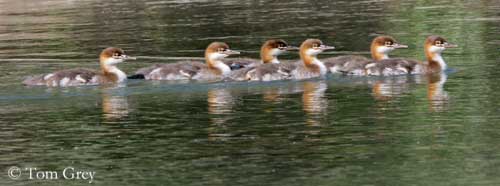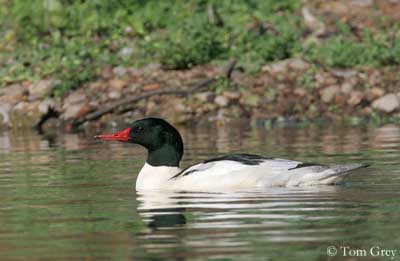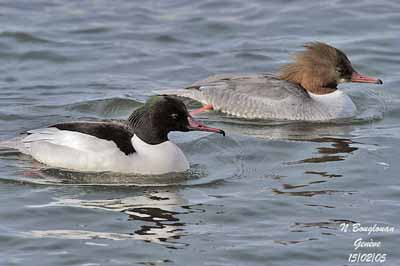
Fr: Harle bièvre
All : Gänsesäger
Esp : Serreta Grande
Ital : Smergo maggiore
Nd: Grote Zaagbek
Sd: Storskrake
Photographers:
Garvie Steve
RAINBIRDER Photo galleries
Grey Tom
Tom Grey's Bird Pictures
Merigan Tom
Tom Merigan’s Photo Galleries
Moul Bob
Nature Photography
Bouglouan Nicole
PHOTOGRAPHIC RAMBLE
Texte de Nicole Bouglouan
Sources:
HANDBOOK OF THE BIRDS OF THE WORLD vol 1 by Josep del Hoyo-Andrew Elliot-Jordi Sargatal - Lynx Edicions - ISBN: 8487334105
THE HANDBOOK OF BIRD IDENTIFICATION FOR EUROPE AND THE WESTERN PALEARCTIC by Mark Beaman, Steve Madge - C.Helm - ISBN: 0713639601
THE COMPLETE BOOK OF BRITISH BIRDS – Written by “Royal Society for the Protection of Birds” experts - Préface de Magnus Magnusson - Michael Cady- Rob Hume Editors - ISBN: 0749509112
GUIDE DES CANARDS, DES OIES ET DES CYGNES – de Steve Madge - Delachaux et Niestlé - ISBN: 2603013769
ENCYCLOPEDIE DES OISEAUX DE FRANCE ET D’EUROPE – de Peter Hayman et Rob Hume - Flammarion – ISBN : 2082009920
Goosander
Mergus merganser
Anseriforme Order – Anatidae Family
BIOMETRICS:
Length: 58-66 cm
Wingspan: 82-97 cm
Weight: 898-2160 g
DESCRIPTION:
The Goosander belongs to the “sawbill” family, because of the long, thin, serrated bill very well adapted to its feeding behaviour.

The adult male in breeding plumage has black head and upper neck, with green gloss.
On the upperparts, the central part of the back is black bordered by a white stripe on the sides. The wing tips are black too, contrasting with the large white wing patch. The scapulars are grey, as the rest of the upperparts and the tail.
The lower neck is white, as underparts and underwing. We can see a pinkish wash on the underparts.
The long, thin bill is deep red with black culmen and nail. The eyes are dark brown. The legs and the webbed feet are red.
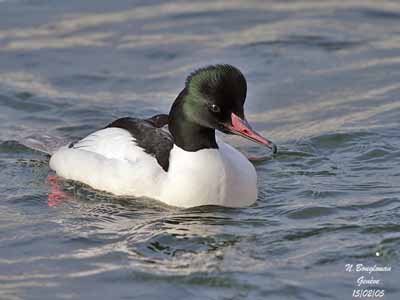
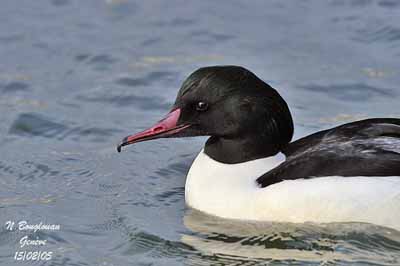
The male in eclipse has grey body above, with dark brown head and upper neck sides. Chin, throat and breast are whitish. The upper wing is similar to the breeding plumage.
Both adults have fairly long crest on the crown and the nape. Female has longer crest than male.
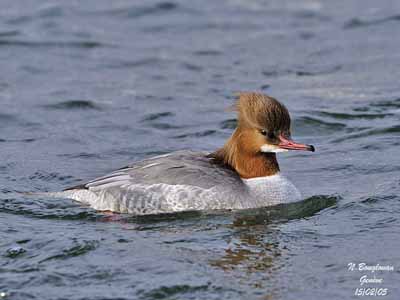
Female and juvenile resembles male in eclipse.
The juvenile has less clean contrast between the brown neck and the white chin and throat than in adults. It also has browner bill, legs and feet. Its crest is shorter and we can see a black-edged white stripe from lores to the eye.
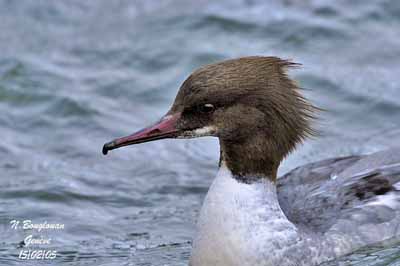
We can find three subspecies:
M.m. merganser is found in Palaearctic, from Iceland, E to Kamchatka, S to C Europe, NE China and N Japan.
M.m. orientalis (not displayed) is found in C Asia from NE Afghanistan, E through Tibet and Himalayas to W China.
This one is larger with thinner bill.
M.m. americanus is found in North America from Alaska to Newfoundland, S to N and W USA.
It has darker and stouter bill base, and an obvious black band formed by the greater covert bases.
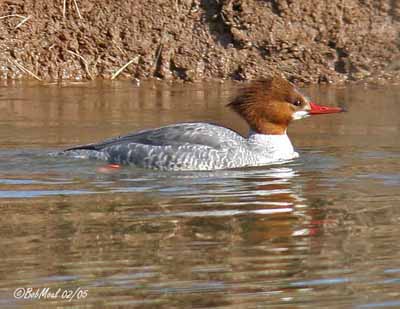
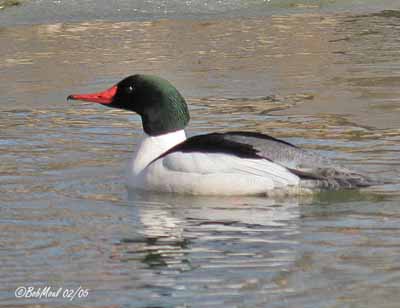
VOICE: SOUNDS BY XENO-CANTO
The Goosander is mostly silent, but during the courtship displays, the male utters nasal “ouig-a”, while the female gives shrill calls “prrak, prrak”.
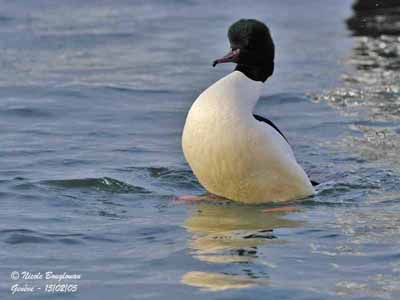
HABITAT:
The Goosander breeds on freshwater lakes and pools and in upper reaches of the rivers with close trees.
This species winters on larger lakes and rivers where the water is unfrozen, but also in lagoons and brackish marshes, rarely on the coast.
RANGE:
See above in “subspecies”.
BEHAVIOUR:
The Goosander feeds mainly on fish. Thanks to its sharply serrated bill, this duck can have a good grip on the slippery preys with the cutting edges. It pursues the prey underwater and propels itself only with the webbed feet. The fish can be swallowed underwater, but usually, the Goosander returns to the surface with its prey. It swallows it head first.
It also catches aquatic invertebrates, amphibians, and also small mammals and birds, and sometimes but rarely, plant items.
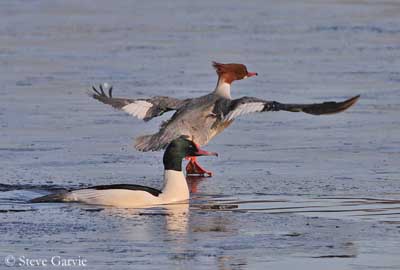
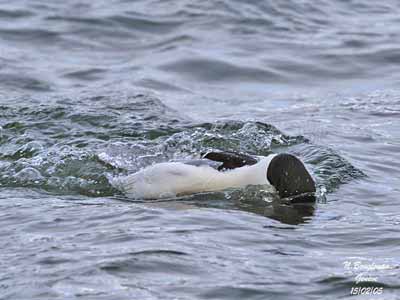
Its usual feeding behaviour consists in diving from the surface after looking underwater with the submerged head. It may also perform upending as other Anatidae species.
This species occurs in small groups, but outside the breeding season, they can form larger flocks with several thousands of birds in some regions where they winter.
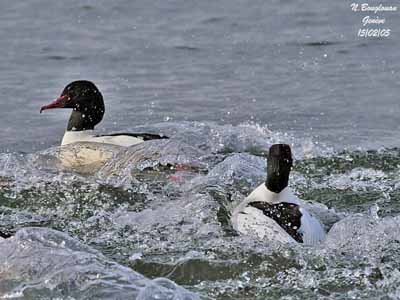
The pair forms at the end of the wintering period and during the migration towards the breeding range.
The male performs courtship displays by the way of several postures, series of ritualized movements during which the male utters several types of sounds.
The male drops the tail and throws the head backwards and moves quickly its open bill while it gives clear sounds, soft notes and a low cat-like mewing. Copulation takes place on the water.
The Goosander is partially migratory. The northernmost populations move southwards towards Mexico, Mediterranean Basin, S URSS, N India and SE Asia. The birds of the temperate ranges are mainly sedentary, only moving over short distances.
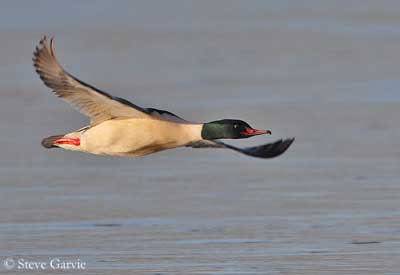
FLIGHT:
The Goosander flies with stretched neck and head, and appears long and large. It performs fast wing beats and its flight is powerful.
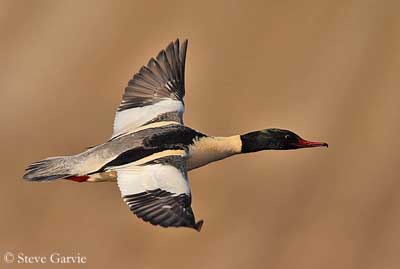
REPRODUCTION:
The breeding season starts between March and May.
The Goosander can be solitary nester, but they also can be found in loose groups. This species is a cavity nester, using tree holes or abandoned cavity excavated by woodpeckers, or nest boxes and other types of cavities, close to the water. Only some down is added to the nest.
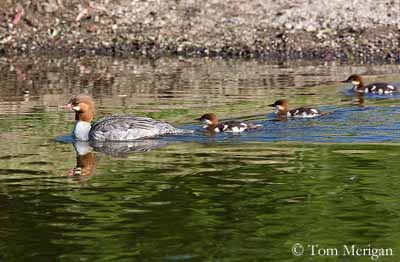
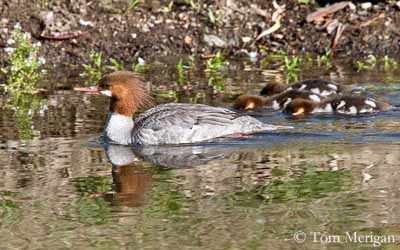
The female lays 8-12 eggs, but sometimes several females can lay in the same nest. She incubates during about one month while the male leaves the site to migrate and moult.
The chicks are covered in greyish-brown down above, and white below. They leave the nest two days after hatching, by jumping through out the nest entrance. They fledge at 60-70 days of age and can fly at ten weeks. They reach their sexual maturity at two years.
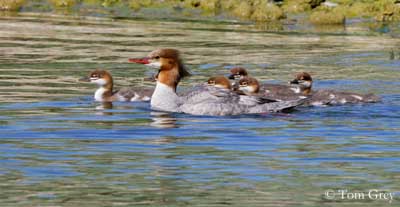
DIET:
The Goosander feeds mainly on fish, but it also takes aquatic invertebrates such as crustaceans, molluscs, worms, insects and larvae. It can catch amphibians, but also small mammals and birds, and sometimes some plant items.
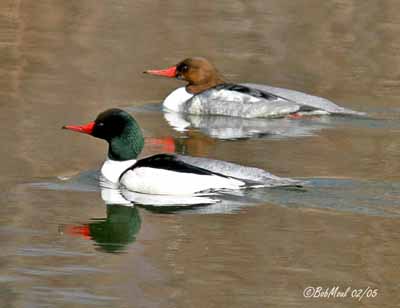
PROTECTION / THREATS / STATUS:
The Goosander’s populations seem to be stable or slightly increasing after alteration by human of their breeding habitat. The species is still subject to persecution by fish-farmers, but the populations are not threatened at this moment.
